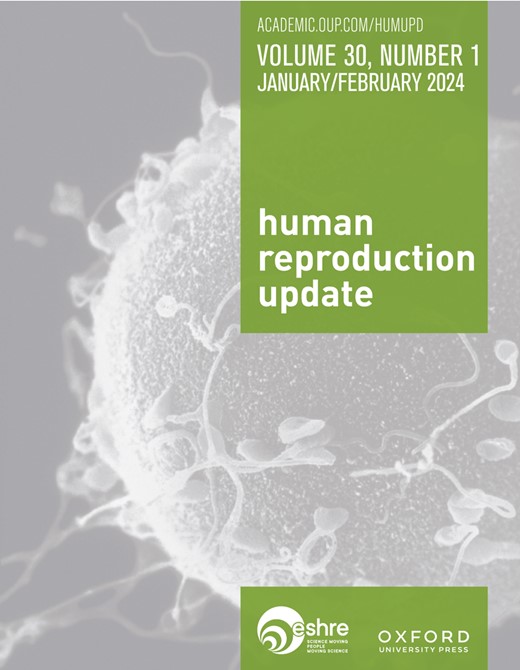Planned oocyte cryopreservation: a systematic review and meta-regression analysis
IF 16.1
1区 医学
Q1 OBSTETRICS & GYNECOLOGY
引用次数: 0
Abstract
BACKGROUND Awareness of the age-related decline in fertility potential has increased the popularity of planned oocyte cryopreservation (POC). However, data regarding outcomes of POC, including rates of women returning to thaw oocytes, as well as pregnancy and live birth rates, are scarce and based mostly on small case series. OBJECTIVE AND RATIONALE POC was defined as cryopreservation exclusively for prevention of future age-related fertility loss. The primary outcome was live birth rate per patient. The secondary outcomes included the return to thaw rate and laboratory outcomes. A meta-regression analysis examining the association between live birth and age above 40 or below 35 was conducted. SEARCH METHODS We conducted a systematic database search from inception to August 2022. The search included PubMed (MEDLINE) and EMBASE. Our search strategies employed a combination of index terms (Mesh) and free text words to compile relevant concepts. The systematic review and meta-regression were undertaken following registration of systematic review (PROSPERO registration number CRD42022361791) and were reported following guidelines of Preferred Reporting Items for Systematic Review and Meta-Analyses 2020 (PRISMA 2020). OUTCOMES The database search yielded 3847 records. After the selection process, 10 studies, conducted from 1999 to 2020, were included. Overall, 8750 women underwent POC, with a mean cryopreservation age of 37.2 (±0.8). Of those, 1517 women returned to use their oocytes with a return rate of 11.1% (± 4.7%). The mean age at the time of cryopreservation for women who returned to use their oocytes was 38.1 (±0.4), with an average of 12.6 (±3.6) cryopreserved oocytes per woman. In a meta-analysis, the oocyte survival rate was 78.5% with a 95% CI of 0.74–0.83 (I2 = 93%). The live birth rate per patient was 28% with a 95% CI of 0.24–0.33 (I2 = 92%). Overall, 447 live births were reported. In a sub-group analysis, women who underwent cryopreservation at age ≥40 achieved a live birth rate per patient of 19% (95% CI 0.13–0.29, I2 = 6%), while women aged ≤35 years old or younger had a higher live birth rate per patient of 52% (95% CI 0.41–0.63, I2 = 7%). WIDER IMPLICATIONS POC emerges as a feasible option for women aiming to improve their chances of conceiving at a later reproductive age. Nonetheless, it must be acknowledged that the overall success rates of POC are limited and that the likelihood of successful live birth declines as the age at cryopreservation rises. With increasing interest in POC, the collation of comprehensive and high-quality data is imperative to clearly define the outcomes for various age groups. REGISTRATION NUMBER CRD42022361791.计划性卵母细胞冷冻:系统综述和元回归分析
背景:随着年龄的增长,人们逐渐意识到生育能力的下降,因此有计划地进行卵母细胞冷冻保存(POC)越来越受欢迎。然而,有关 POC 的结果(包括妇女返回解冻卵母细胞的比率以及怀孕率和活产率)的数据却很少,而且大多基于小型病例系列。目标和原理 POC 被定义为专门为预防未来与年龄相关的生育能力丧失而进行的冷冻保存。主要结果是每位患者的活产率。次要结果包括解冻恢复率和实验室结果。对活产率与 40 岁以上或 35 岁以下年龄之间的关系进行了元回归分析。检索方法 我们进行了从开始到 2022 年 8 月的系统性数据库检索。检索包括 PubMed (MEDLINE) 和 EMBASE。我们的检索策略采用了索引词(Mesh)和自由文本词相结合的方式来汇编相关概念。系统综述和荟萃回归是在系统综述注册(PROSPERO 注册号为 CRD42022361791)后进行的,并按照《2020 年系统综述和荟萃分析首选报告项目》(PRISMA 2020)指南进行报告。结果 数据库搜索共获得 3847 条记录。经过筛选,共纳入了 10 项研究,这些研究是在 1999 年至 2020 年期间进行的。共有 8750 名女性接受了 POC,平均冷冻年龄为 37.2 (±0.8)岁。其中,1517 名妇女返回使用了她们的卵母细胞,返回率为 11.1%(± 4.7%)。返回使用卵母细胞的妇女冷冻保存时的平均年龄为 38.1(±0.4)岁,平均每位妇女冷冻保存 12.6(±3.6)个卵母细胞。在一项荟萃分析中,卵母细胞存活率为 78.5%,95% CI 为 0.74-0.83(I2 = 93%)。每位患者的活产率为 28%,95% CI 为 0.24-0.33 (I2 = 92%)。总计报告了 447 例活产。在一项亚组分析中,年龄≥40 岁时接受冷冻保存的女性每例活产率为 19% (95% CI 0.13-0.29, I2 = 6%),而年龄≤35 岁或更小的女性每例活产率更高,为 52% (95% CI 0.41-0.63, I2 = 7%)。更广泛的启示 对于希望提高晚育几率的女性来说,POC 是一个可行的选择。然而,必须承认的是,POC 的总体成功率是有限的,而且随着冷冻年龄的增加,成功活产的可能性也在下降。随着人们对 POC 的兴趣与日俱增,当务之急是整理全面、高质量的数据,以明确界定不同年龄组的结果。注册号:CRD42022361791。
本文章由计算机程序翻译,如有差异,请以英文原文为准。
求助全文
约1分钟内获得全文
求助全文
来源期刊

Human Reproduction Update
医学-妇产科学
CiteScore
28.80
自引率
1.50%
发文量
38
期刊介绍:
Human Reproduction Update is the leading journal in its field, boasting a Journal Impact FactorTM of 13.3 and ranked first in Obstetrics & Gynecology and Reproductive Biology (Source: Journal Citation ReportsTM from Clarivate, 2023). It specializes in publishing comprehensive and systematic review articles covering various aspects of human reproductive physiology and medicine.
The journal prioritizes basic, transitional, and clinical topics related to reproduction, encompassing areas such as andrology, embryology, infertility, gynaecology, pregnancy, reproductive endocrinology, reproductive epidemiology, reproductive genetics, reproductive immunology, and reproductive oncology. Human Reproduction Update is published on behalf of the European Society of Human Reproduction and Embryology (ESHRE), maintaining the highest scientific and editorial standards.
 求助内容:
求助内容: 应助结果提醒方式:
应助结果提醒方式:


